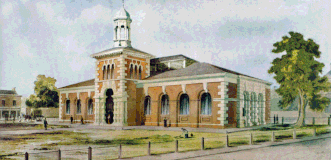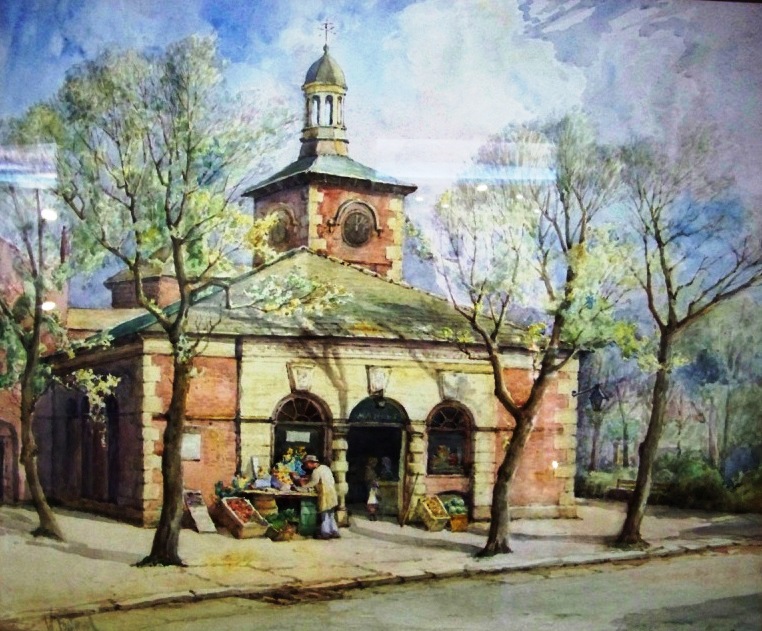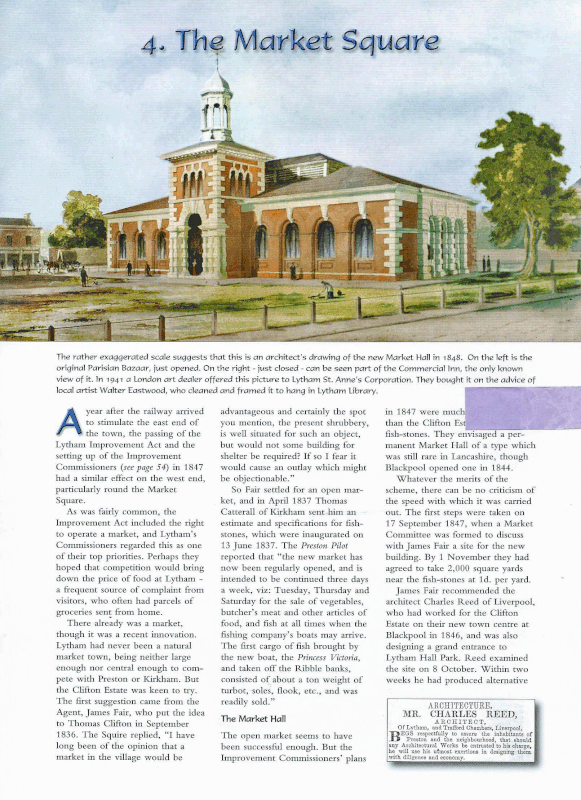Lytham Market Hall
|
Research by Sue Cannon
|
|
Acc No 166
Artist Walter Eastwood Artist dates 1867-1943 Date painted unknown Medium watercolour Size 76.2 x 63.5 cm (30 x 25 in) Donor The Rotary Club, Lytham St Annes (external link) in memory of the artist who was a member of the Club 1928-1943 Date donated 29 August 1944 Walter Eastwood Biography from Lytham Heritage Group |

This watercolour painting of the town's Grade 2 listed red brick and sandstone Market Hall building in Lytham Square is viewed from approximately the corner of Queen Street across the main road which runs through Lytham town centre from the West. He has chosen to capture the side view of the building, together with the Italianate style clock tower, rather than view the full frontage from the Memorial Gardens in the Square, where he had a photographic shop and also sold his own paintings. Walter would have had a clear view of the whole building from his shop window, which was 17 The Square, where ‘Poppy Women's Fashions’ is today, 2015. He would have seen the single storey building and the three storey centre clock tower, with it’s nine arcaded bays, spread across The Square in front of the present day War Memorial and Gardens. It is a central feature in the middle of town. Built at a cost of fourteen thousand pounds in 1848 by the architect, Charles Reed, it replaced the original cobble and fish stone open market. The clock tower was added in 1869 by Lady Eleanor Cecily Clifton when a third storey was added to accommodate it. At that time the markets were held on Tuesdays and Saturdays. In the 1850s two annual cattle markets were held, one in April and one in September. (see amounderness.co.uk website)
Interestingly, Walter Eastwood came to Lytham in 1902, approximately ten years after the Hall, which was unsuccessful as an open market, was turned into enclosed shops, though Walter may have visited and remembered a time when it was in use. You certainly feel this is the mood he is trying to capture within this sunny spring time scene - times gone by. We see the leaves on the four elm trees just coming into bloom, whilst the building is bathed in warm yellow sunlight with the shadows of the trees softly reflected onto the building walls; the blue and mossy green slate roof creating height and a three dimensional space. The focal point is the building and clock tower with the market set in a shallow almost empty street and space. We see the shopkeeper with his back to us looking at his fruit and vegetables displayed on a table resting on barrels and in boxes on either side of the shop frontage. The bright sunlight is contrasted by the interior dark shadows within the rounded arcaded windows and door suggesting the space within. Our eyes then rise and follow the trees and branches, similar to outstretched fingers, expressing space, height and movement revealing the clock tower and bellcote at the top.
The pale mauves and blues of the sky set against the dappled leaves on the trees, together with the impressionistic style of the Memorial Gardens in the Square beyond, add to the ethereal lightness and peace of the scene set around the solid three dimensional structure of Lytham Market Hall on this important site.
unknown artist
Lytham Market Hall
architectural drawing
conserved by Walter Eastwood
medium watercolour
size 60.95 x 50.8 cm (24x 20 in)
acc. no. 165
purchased by Lytham St Annes Corporation in 1941
The rather exaggerated scale suggests that this is an architect's drawing of the new Market Hall in 1848. On the left is the original Parisian Bazaar, just opened. On the right - now closed - can be seen part of the Commercial Inn, the only known view of it. In 1941 a London art dealer offered this picture to Lytham St. Annes Corporation. They bought it on the advice of local artist Walter Eastwood, who cleaned and framed it to hang in Lytham Library. (Image and text reproduced from Brian Turner's book, 'Victorian Lytham', published St Annes Civic Society, p25) see below
Interestingly, Walter Eastwood came to Lytham in 1902, approximately ten years after the Hall, which was unsuccessful as an open market, was turned into enclosed shops, though Walter may have visited and remembered a time when it was in use. You certainly feel this is the mood he is trying to capture within this sunny spring time scene - times gone by. We see the leaves on the four elm trees just coming into bloom, whilst the building is bathed in warm yellow sunlight with the shadows of the trees softly reflected onto the building walls; the blue and mossy green slate roof creating height and a three dimensional space. The focal point is the building and clock tower with the market set in a shallow almost empty street and space. We see the shopkeeper with his back to us looking at his fruit and vegetables displayed on a table resting on barrels and in boxes on either side of the shop frontage. The bright sunlight is contrasted by the interior dark shadows within the rounded arcaded windows and door suggesting the space within. Our eyes then rise and follow the trees and branches, similar to outstretched fingers, expressing space, height and movement revealing the clock tower and bellcote at the top.
The pale mauves and blues of the sky set against the dappled leaves on the trees, together with the impressionistic style of the Memorial Gardens in the Square beyond, add to the ethereal lightness and peace of the scene set around the solid three dimensional structure of Lytham Market Hall on this important site.
unknown artist
Lytham Market Hall
architectural drawing
conserved by Walter Eastwood
medium watercolour
size 60.95 x 50.8 cm (24x 20 in)
acc. no. 165
purchased by Lytham St Annes Corporation in 1941
The rather exaggerated scale suggests that this is an architect's drawing of the new Market Hall in 1848. On the left is the original Parisian Bazaar, just opened. On the right - now closed - can be seen part of the Commercial Inn, the only known view of it. In 1941 a London art dealer offered this picture to Lytham St. Annes Corporation. They bought it on the advice of local artist Walter Eastwood, who cleaned and framed it to hang in Lytham Library. (Image and text reproduced from Brian Turner's book, 'Victorian Lytham', published St Annes Civic Society, p25) see below


